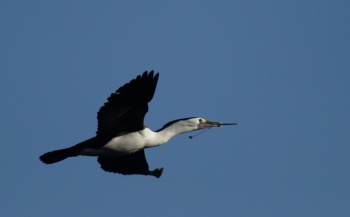Alternative Name: Pied Shag
- Phalacrocorax varius
Identification
81 cm., 2 kg
Black above, face from above eye and all underparts white except for black thighs, long grey hooked bill, yellow and orange face, eye-ring blue, feet black.
Distribution
Australasia: found in
Papua New Guinea, Australia: New South Wales, Northern Territory, Queensland, South Australia, Victoria, Western Australia, New Zealand, Melanesia.
The Pied Cormorant is a protected species and is increasing dramatically in numbers in New Zealand's coastal waters.
Taxonomy
Subspecies[1]
- P. v. hypoleucos:
- P. v. varius:
- Coastal New Zealand and Stewart Island
Habitat
Marine and inland waters, including billabongs, deep and open swamps, and rivers.
P.v.varius breeds throughout New Zealand with colonies in macrocarpa and pohutakawa trees being a distinctive feature of Northern New Zealand’s coastal environment. Despite being almost an entirely coastal feeding species, Pied Cormorants nest inland at Kaikoura at Lake Rotorua.
Behaviour
Pied Cormorants, P.v.varius, are a coastal species and rarely venture more than a kilometre or so offshore. They are a social species and groups of birds can be seen resting on beaches, although they are generally a solitary species when feeding.
Diet
Feeds on coastal fish such as mullet and flounders and also paddle crabs. Pied Cormorants dive below the surface to feed, diving down to depths of 20 metres.
References
- Clements, JF. 2008. The Clements Checklist of Birds of the World. 6th ed., with updates to December 2008. Ithaca: Cornell Univ. Press. ISBN 978-0801445019.
- Avibase
- BF Member observations
Recommended Citation
- BirdForum Opus contributors. (2024) Pied Cormorant. In: BirdForum, the forum for wild birds and birding. Retrieved 26 April 2024 from https://www.birdforum.net/opus/Pied_Cormorant
External Links
GSearch checked for 2020 platform.1






